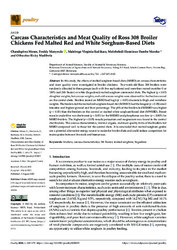Carcass characteristics and meat quality of ross 308 broiler chickens fed malted red and white sorghum-based diets
Date
2022-06-28Author
Moses, Chandapiwa
Manyeula, Freddy
Radikara, Malebogo Virginia
Mareko, Molebeledi Horatious Dambe
Madibela, Othusitse Ricky
Metadata
Show full item recordAbstract
In this study, the effects of malted sorghum-based diets (MSBD) on carcass characteristics and meat quality were investigated in broiler chickens. Two-week-old Ross 308 broilers were randomly allocated to three groups (each with five replications) and were then reared on either 0 or 100% (red (Mr Buster) or white (Segaolane)) malted sorghum commercial diets. The highest (p < 0.05) slaughter weights, hot carcass weights, and cold carcass weights were observed for the broilers reared on the control diets. Broilers reared on MSBD had high (p < 0.05) drumstick–thigh and vertebrae weights. The broilers fed the malted red sorghum-based diet (MRSBD) had the longest (p < 0.05) small intestine and highest gizzard and liver percentage. The pHi of the broilers fed MRSBD was higher (p < 0.05) than the broilers on the control or malted white sorghum-based diet (MWSBD). Breast muscle crude fibre was the lowest (p < 0.05) for the MRSBD and phosphorus was low (p < 0.005) for MSBD broilers. The highest (p < 0.05) muscle potassium and magnesium was found in the control diet broilers. The carcass characteristics, internal organs, and meat quality traits of the broilers fed MSBD compared well to those fed the control diets. It is concluded that malted sorghum grains are a potential alternative energy source to maize for broiler diets and could reduce competition for maize grains between livestock and human use
Collections
- Research articles [172]

